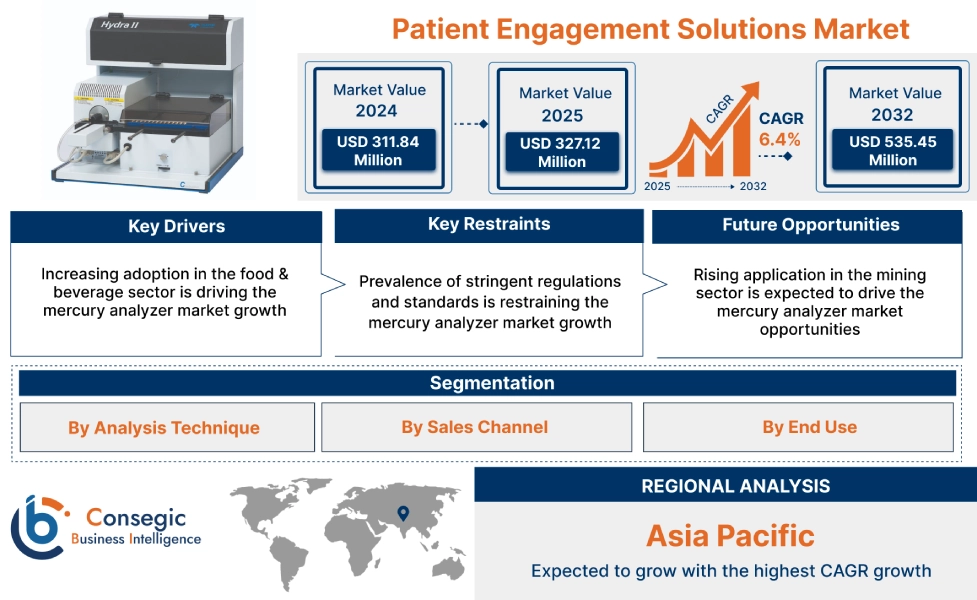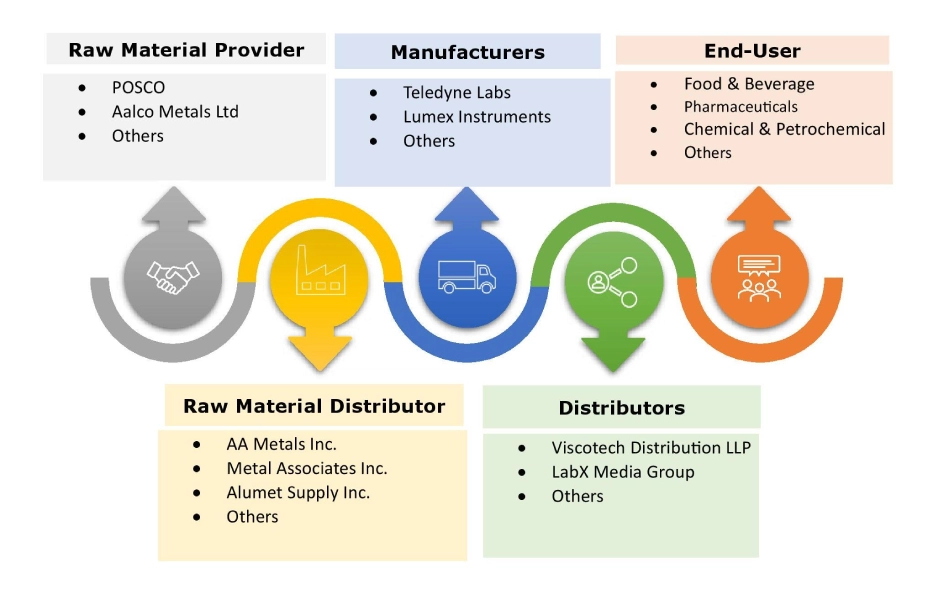Mercury Analyzer Market Size:
Mercury Analyzer Market size is estimated to reach over USD 535.45 Million by 2032 from a value of USD 311.84 Million in 2024 and is projected to grow by USD 327.12 Million in 2025, growing at a CAGR of 6.4% from 2025 to 2032.
Mercury Analyzer Market Scope & Overview:
A mercury analyzer is a scientific instrument designed to detect and measure the concentration of mercury (Hg) in various sample types, including solids, liquids, and gases. These analyzers are crucial for environmental monitoring, industrial processes, and safety assessments due to mercury's toxicity. Additionally, mercury analyzing instruments are primarily used in environmental monitoring, food & beverage, chemical & petrochemical, mining, oil & gas, and other industrial applications.
How is AI Transforming the Mercury Analyzer Market?
The integration of AI is significantly transforming the mercury analyzer market. AI is being used to enable more accurate, efficient, and automated examination of mercury levels in various applications. This includes enhanced data analytics, real-time diagnostics, predictive modeling, and streamlined workflows.
Moreover, AI-powered analyzers can also improve data management, signal processing, and remote monitoring capabilities. Further, AI-powered systems can automate calibration routines, in turn reducing manual intervention and ensuring consistent accuracy. Hence, the aforementioned factors are expected to positively impact the market growth in the upcoming years.
Mercury Analyzer Market Dynamics - (DRO) :
Key Drivers:
Increasing adoption in the food & beverage sector is driving the mercury analyzer market growth
Mercury analyzers are primarily used in the food & beverage sector, particularly for detecting and quantifying mercury levels in various products to ensure safety and compliance with regulations. These analyzers utilize techniques such as direct thermal decomposition, atomic absorption spectrometry, and others to analyze solids, liquids, and gases. Additionally, factors including rising food production, prevalence of stringent food safety regulations and standards, along with the growing need for advanced solutions for monitoring and controlling mercury levels in food products, are key aspects driving the market.
- For instance, according to Food Drink Europe, the European Union food and beverage sector was valued at EUR 1,121 billion (USD 1,196.7 billion) in 2022, demonstrating an incline of 2.6% in comparison to EUR 1,093 billion (USD 1,166.8 billion) in 2021.
Thus, the rising adoption of mercury analyzing instruments in food & beverage sector for improved monitoring and control of mercury levels in food products is driving the mercury analyzer market size.
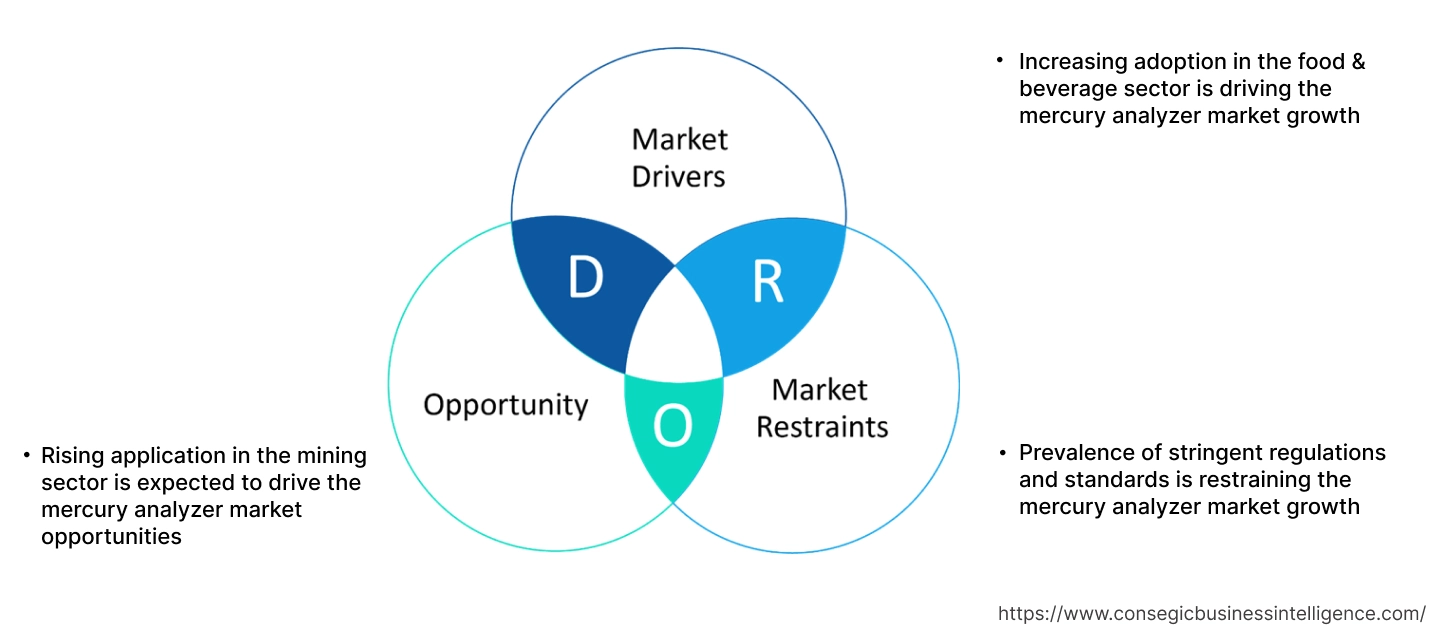
Key Restraints :
Prevalence of stringent regulations and standards is restraining the mercury analyzer market growth
Mercury analyzing instruments are used in various industries, including food & beverage, pharmaceutical, chemical, and others. However, mercury analyzing instrument manufacturers have to comply with numerous stringent standards associated with the production of mercury analyzing instruments, which is a prime factor restricting the market growth. For instance, mercury analyzing instrument manufacturers have to comply with various standards such as the International Organization for Standardization: ISO 23674, Environmental Protection Agency (EPA) standards, and ASTM (American Society for Testing and Materials) standards, among others.
ISO 23674 standard is specifically mentioned in the context of direct mercury analysis in cosmetics, and highlights the methodology and validation requirements. Additionally, EPA standards/methods, including 245.1 and 1631 are frequently referenced for mercury analysis in environmental monitoring. Therefore, the prevalence of the aforementioned standards associated with mercury analyzing instruments is hindering the mercury analyzer market expansion.
Future Opportunities :
Rising application in the mining sector is expected to drive the mercury analyzer market opportunities
Mercury analyzers are often used in the mining industry, particularly for detecting and quantifying mercury levels in various samples, which helps ensure environmental compliance and worker safety. Mining activities can release mercury into the environment, potentially contaminating soil, water, and air. Mercury analyzing instruments are used to monitor these potential mercury releases, which helps mining operations comply with environmental regulations and minimize their ecological footprint. Additionally, these analyzers also help in monitoring mercury levels in the mining workplace, which enables timely interventions to protect worker health.
- For instance, according to the Minerals Council of Australia, there are over 100 prospective mining and processing projects with a total investment of approximately USD 50 billion in Australia.
Hence, rising investments in mining projects are expected to increase the demand for advanced mercury analyzing instruments in mining sites to ensure environmental compliance and worker safety, in turn driving the mercury analyzer market opportunities during the forecast period.
Mercury Analyzer Market Segmental Analysis :
By Analysis Technique:
Based on analysis technique, the market is segmented into cold vapor atomic absorption (CVAA), cold vapor atomic fluorescence (CVAF), and others.
Trends in the analysis technique:
- Increasing trend in adoption of CVAA-based mercury analyzing instruments in environmental monitoring, food safety, and industrial applications is driving the market growth.
- There is a rising trend towards utilization of CVAF analyzers, due to its several benefits such as sensitivity and selectivity, wide dynamic range, versatility in sample types, and others.
Cold vapor atomic absorption (CVAA) segment accounted for a substantial revenue share in the mercury analyzer market share in 2024.
- Cold vapor atomic absorption (CVAA) is a commonly used technique for mercury analytics. CVAA-based mercury analyzing instruments offer high vapor pressure at room temperature, which facilitates efficient measurement of mercury in various sample matrices.
- The CVAA process involves reducing mercury ions to elemental mercury, which is then measured using atomic absorption spectroscopy.
- Moreover, CVAA-based mercury analyzing instruments provide a range of benefits, including high sensitivity, cost-effectiveness, and others.
- For instance, Teledyne Labsoffers QuickTrace M-7600 model of CVAA mercury analyzer in its product offerings. The QuickTrace M-7600 is primarily designed for routine and research applications in a broad range of settings, including environmental laboratories, research institutes, and others.
- According to the mercury analyzer market analysis, the increasing advancements associated with CVAA-based mercury analyzing instruments are further driving the market.
The cold vapor atomic fluorescence (CVAF) segment is anticipated to register a significant CAGR during the forecast period.
- Cold vapor atomic fluorescence (CVAF) is a highly sensitive technique for quantifying mercury, specifically at ultra-trace levels.
- The technique involves converting mercury in a sample to its elemental form, which is then carried into a measurement cell where it is exposed to ultraviolet (UV) light. The mercury atoms absorb the UV light and then fluoresce, emitting light that is detected to determine the mercury concentration.
- CVAF analyzers are used in various applications, including environmental monitoring and industrial process control.
- In addition, CVAF analyzers offer a broad range of benefits, including high sensitivity and selectivity,wide dynamic range, versatility in sample types, and others.
- Therefore, the above benefits of CVAF analyzers are further expected to drive its adoption, in turn boosting the mercury analyzer market size during the forecast period.
By Sales Channel:
Based on sales channel, the market is segmented into direct sales and distributor sales.
Trends in the sales channel:
- Factors including the availability of excellent support and warranty, higher product quality, and reliable shipping and return policies are key trends driving the direct sales channel segment.
- Factors such as higher accessibility to a variety of products, higher flexibility, and expanded reach are major determinants for driving the distributor sales channel segment.
Direct sales segment accounted for a significant revenue in the overall mercury analyzer market share in 2024.
- In direct sales channel, mercury analyzing instruments are sold directly to customers through numerous physical outlets such as company outlets.
- Moreover, the direct sales channel also consists of online mode, wherein the manufacturers sell mercury analyzing instruments through their own company websites.
- Additionally, purchasing mercury analyzing instruments from direct sales channel offers numerous benefits, including faster response time, higher product quality, competitive pricing, higher return on investments, and others, which are key determinants for increasing the purchase of mercury analyzing instruments from direct sales channel.
- For instance, Lumex Instruments is a mercury analyzing instrument manufacturer that offers multiple series of mercury analyzers for direct purchase through the company website.
- Therefore, increasing availability of mercury analyzing instruments in direct sales channels is driving the mercury analyzer market trends.
The distributor sales segment is anticipated to register the fastest CAGR during the forecast period.
- The distributor sales channel includes indirect distribution of mercury analyzers, wherein these analyzers are purchased from several regional distributors operating in multiple regions worldwide.
- Moreover, distributor sales channels provide several benefits, including extended market reach, increased cost efficiency, reduced capital expenditure, and others. The aforementioned benefits of distributor sales channels are increasing its utilization for the purchase of mercury analyzing instruments.
- For instance, Viscotech Distribution LLP,LabX Media Group, and others are few of the distributors of mercury analyzing instruments.
- Hence, the increasing availability of mercury analyzing instruments in distributor sales channels isprojected to drive the market during the forecast period.
By End Use:
Based on the end use, the market is segmented into environmental monitoring, food & beverage, chemical & petrochemical, mining, oil & gas, pharmaceutical, and others.
Trends in the end use:
- Rising adoption of mercury analyzing instruments in environmental monitoring applications for detection and quantification of mercury in various environmental matrices, such as air, water, and soil, is driving the market.
- Factors including rising food production, prevalence of stringent food safety regulations and standards, along with the growing need for advanced solutions for monitoring and controlling mercury levels in food products, are key trends driving the food & beverage segment.
The environmental monitoring segment accounted for the largest revenue share of 31.75% in the market in 2024.
- Mercury analyzing instruments play a crucial role in environmental monitoring for facilitating the detection and quantification of mercury in various environmental matrices such as air, water, and soil.
- These analyzers play a vital role in assessing pollution levels, which helps in ensuring compliance with environmental regulations and safeguarding human health.
- Mercury analyzing instruments are used to measure mercury levels in ambient air, stack emissions from industrial processes, and workplace environments, which helps in identifying and mitigating mercury pollution sources.
- Similarly, they are also used to analyze mercury concentrations in surface water, groundwater, and wastewater, ensuring that water bodies meet safety standards and protecting aquatic ecosystems.
- Additionally, mercury analyzing instruments help assess mercury levels in soil samples, further assisting in the identification of contaminated sites and informing remediation efforts.
- Hence, the rising adoption of mercury analyzing instruments for environmental monitoring applications is driving the market growth.
The food & beverage segment is anticipated to register a significant CAGR during the forecast period.
- Mercury analyzing instruments are often used in the food & beverage sector, particularly for detecting and quantifying mercury levels in various products to ensure safety and compliance with regulations.
- These analyzers utilize techniques such as direct thermal decomposition, atomic absorption spectrometry, and others to analyze solids, liquids, and gases.
- For instance, Kerry Group, a food and beverage company, announced the launch of its new food manufacturing facility in Georgia, United States, in 2022. The food manufacturing facility was developed to meet the rising consumer demand in seafood, poultry, and alternative protein markets across the United States and Canada.
- Consequently, the rising adoption of these analyzers in food & beverage sector isexpected to drive the market growth during the forecast period.
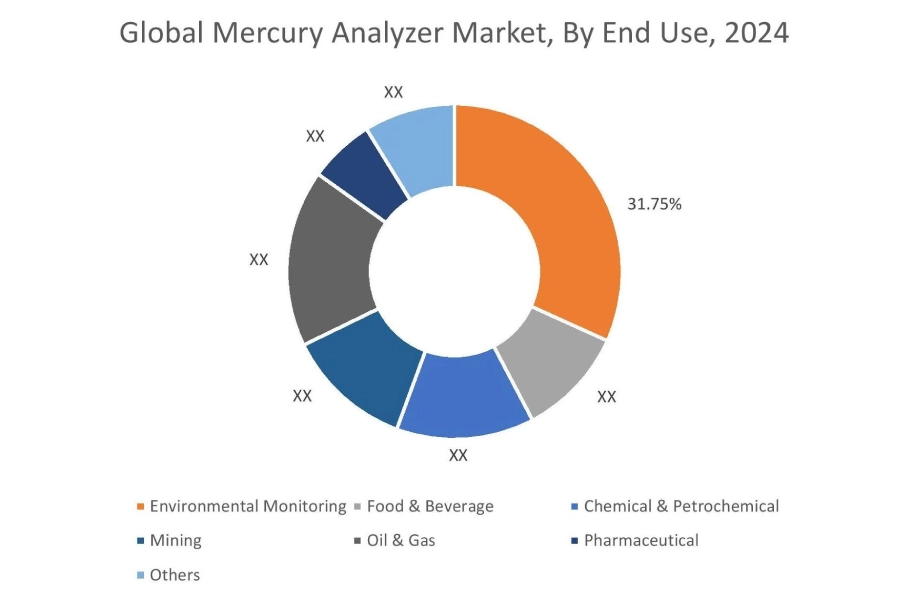
Regional Analysis:
The regions covered are North America, Europe, Asia Pacific, the Middle East and Africa, and Latin America.
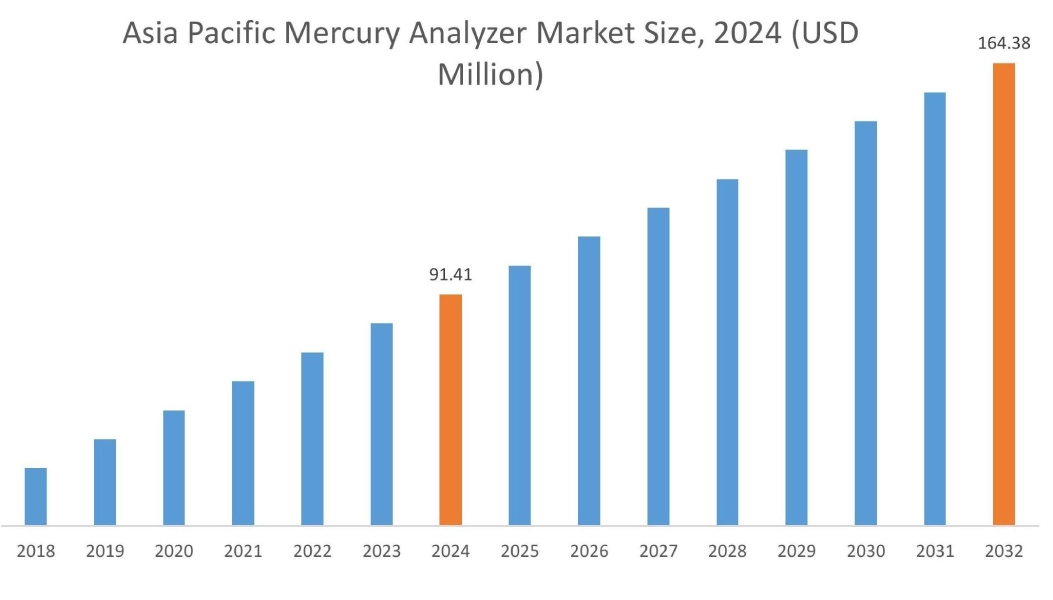
Asia Pacific region was valued at USD 91.41 Million in 2024. Moreover, it is projected to grow by USD 96.27 Million in 2025 and reach over USD 164.38 Million by 2032. Out of this, China accounted for the maximum revenue share of 33.78%. As per the mercury analyzer market analysis, the adoption of mercury analyzing instruments in the Asia-Pacific region is primarily driven by the growing pharmaceutical, oil & gas, and chemical sectors, among others. Additionally, the rising adoption of mercury analyzing instruments during pharmaceutical production is further accelerating the mercury analyzer market expansion.
- For instance, according to the India Brand Equity Foundation, the local pharmaceutical sector in India consists of approximately 3,000 drug companies and 10,500 pharmaceutical manufacturing units. The above factors are further driving the market in the Asia-Pacific region.
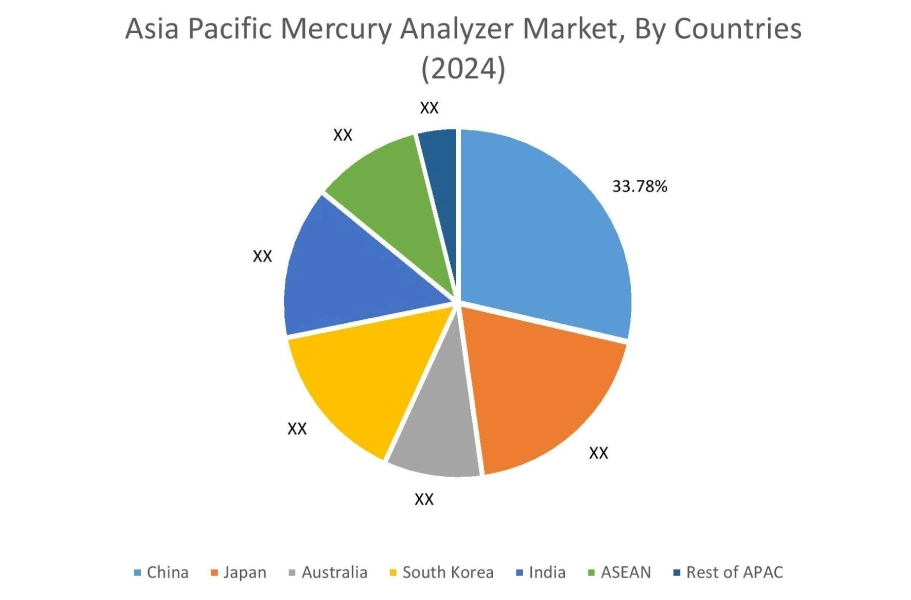
North America is estimated to reach over USD 186.34 Million by 2032 from a value of USD 109.36 Million in 2024 and is projected to grow by USD 114.64 Million in 2025. In North America, the growth of the mercury analyzer industry is driven by the growing food & beverage, chemical, and other sectors. Similarly, the increasing investments in development of chemical manufacturing facilities and rising utilization of mercury analyzing instruments for measuring mercury concentrations in various chemicals and materials are contributing to the mercury analyzer market demand.
- For instance, in November 2023, Evonik, a global specialty chemicals company, announced the development of a new chemical manufacturing plant for producing ultra-high purity colloidal silica at its site in Michigan, United States. The above factors are expected to propel the mercury analyzer market trends in North America during the forecast period.
Meanwhile, the regional analysis depicts that growing chemical, food & beverage, and pharmaceutical sectors are driving the mercury analyzer market demand in Europe. Furthermore, according to the market analysis, the market demand in Latin America, Middle East, and African regions is expected to grow at a considerable rate due to factors such as rising pace of industrialization and increasing adoption of these analyzers in food & beverage, oil & gas, and mining sectors, among others.
Top Key Players & Market Share Insights:
The global mercury analyzer market is highly competitive with major players providing products to the national and international markets. Key players are adopting several strategies in research and development (R&D), product innovation, and end-user launches to hold a strong position in the mercury analyzer market. Key players in the mercury analyzer industry include-
- Teledyne Labs(USA)
- Lumex Instruments(Canada)
- Hitachi High-Tech (Japan)
- Brooks Rand Instruments (USA)
- AMETEK Inc. (USA)
- Nippon Instruments Corporation(Japan)
- ENVEA (France)
- Thermo Fisher Scientific (USA)
- PerkinElmer Inc. (USA)
- Analytik Jena AG (Germany)
Recent Industry Developments :
Product Launches:
- In 2023, Nippon Instruments Corporation launched its RA-7000 model of automated mercury measuring instrument.The instrument is capable of reducing mercury into elemental form and automating the aeration of elemental mercury from solution while conducting measurements by using a cold vapor atomic absorption spectrophotometer.
Mercury Analyzer Market Report Insights :
| Report Attributes | Report Details |
| Study Timeline | 2019-2032 |
| Market Size in 2032 | USD 535.45 Million |
| CAGR (2025-2032) | 6.4% |
| By Analysis Technique |
|
| By Sales Channel |
|
| By End Use |
|
| By Region |
|
| Key Players |
|
| North America | U.S. Canada Mexico |
| Europe | U.K. Germany France Spain Italy Russia Benelux Rest of Europe |
| APAC | China South Korea Japan India Australia ASEAN Rest of Asia-Pacific |
| Middle East and Africa | GCC Turkey South Africa Rest of MEA |
| LATAM | Brazil Argentina Chile Rest of LATAM |
| Report Coverage |
|
Key Questions Answered in the Report
How big is the mercury analyzer market? +
The mercury analyzer market was valued at USD 311.84 Million in 2024 and is projected to grow to USD 535.45 Million by 2032.
Which is the fastest-growing region in the mercury analyzer market? +
Asia-Pacific is the region experiencing the most rapid growth in the mercury analyzer market.
What specific segmentation details are covered in the mercury analyzer report? +
The mercury analyzer report includes specific segmentation details for analysis technique, sales channel, end use, and region.
Who are the major players in the mercury analyzer market? +
The key participants in the mercury analyzer market are Teledyne Labs (USA), Lumex Instruments (Canada), Nippon Instruments Corporation (Japan), ENVEA (France), Thermo Fisher Scientific (USA), PerkinElmer Inc. (USA), Analytik Jena AG (Germany), Hitachi High-Tech (Japan), Brooks Rand Instruments (USA), AMETEK Inc. (USA), and others.
